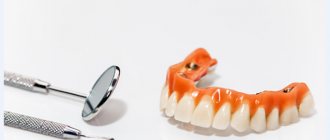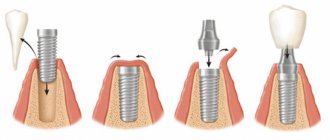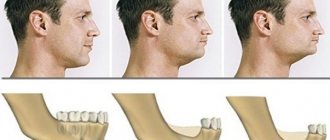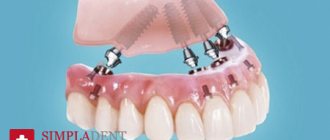What is autologous dental transplantation?
This is a unique surgical operation performed by doctors at our clinic.
Autotransplantation is a procedure in which a healthy tooth is taken from a patient from an area where it is less functional (wisdom tooth, supernumerary tooth). This tooth becomes a donor. It is transplanted to a place where there is a great need for it - if tooth extraction is required (severely damaged tooth, root crack, etc.). That is, autotransplantation is an alternative to traditional implantation. Instead of implanting an implant, your own natural tooth is implanted.
Attention: such a transplant is not possible in all cases; the indications will be determined at a personal appointment and after diagnosis.
Direction: Surgery and implantation
0/0
Autotransplantation is the transplantation of your own tooth. Photo before deletion
After treatment. We implanted a wisdom tooth in place of the extracted tooth.
Doctor: Shirnaliev Ulvi
Direction: Surgery and implantation
0/0
Autotransplantation is the transplantation of your own tooth. Photo before treatment.
A root crack was diagnosed and the tooth was removed.
We implanted a wisdom tooth in place of the extracted tooth.
Doctors: Unzhakova Yulia Kobozev Mikhail
Direction: Surgery and implantation
0/0
Autotransplantation is the transplantation of your own tooth. Before treatment (cracked root of the sixth tooth).
Tooth removed, fitting of wisdom tooth template.
We implanted a figure eight in place of the extracted tooth.
New tooth - after endodontics.
Doctors: Unzhakova Yulia Kobozev Mikhail
What complications can there be?
After autotransplantation, the risk of tooth rejection remains.
According to statistics, this happens in 5-20% of cases, but in fact it greatly depends on the skill of the doctor and the efforts of the patient. There is also a possibility of root resorption of the transplanted teeth and their replacement with bone tissue within 2-4 years. That is, the tooth fuses directly with the bone, without the periodontal ligament. This means that it does not cushion when chewing, and this can create certain problems. But such situations again depend on how carefully the dental surgeon preserved and transferred the roots of the tooth to a new place.
That is, the difficulties in general are associated with a lack of practice - many doctors prefer to immediately offer implantation rather than consider an alternative.
However, even if the tooth does not take root in the new place, this is not a death sentence. Of course, you lose time and money spent on treatment. But even in case of failure, there are still options to install an implant or a bridge. And if the transplantation is successful, you will save significantly.
How does the autotransplantation process work?
- In order for the transplant to be successful, you need to make sure that the donor tooth is the right size for the socket of the tooth that needs to be removed. The doctor evaluates the shape and size of the donor tooth on a CT image.
- We scan the tooth and print a three-dimensional model of the tooth on a 3D printer. It is made of special plastic.
- The doctor tries on the future donor tooth (this happens even before extraction).
- Next, the dental surgeon atraumatically removes the decayed tooth. Places a 3D model of the future donor tooth into the socket and carries out the final fitting.
- The doctor then very carefully removes the donor tooth and moves it into the socket of the newly removed tooth. Places stitches and strengthens with a splint. The surgical part is completed. Next - inspections.
- You have had a tooth transplant. What is important to know? Recommendations from our doctors!
Indications and contraindications
Implantation of natural teeth is indicated in the absence of any tooth - in the smile area or in the chewing region. The purpose of such an operation is to restore the full functioning of the dental system, which is very important for children and adolescents.
But this technique also has contraindications:
- lack of sufficient space for transplantation between adjacent teeth;
- autoimmune diseases, disorders of the endocrine, cardiovascular, and nervous systems;
- local inflammation or infection;
- impaired bone tissue restoration;
- insufficient oral hygiene.
Also important is the patient’s psychological readiness to follow all the doctor’s instructions and the ability to undergo such an operation, since it is performed in childhood and adolescence.
How to minimize the risks of implant rejection
In order not to lose the installed implant, it is important to follow the following recommendations:
- Do not touch the wound with your hands or other objects. In the first few days after implantation, you don’t even have to brush your teeth in close proximity to the implant, so as not to damage the wound in the gum and provoke rejection.
- A day or two after root implantation, you need to visit a doctor’s office for monitoring and possible recommendations for the speedy restoration and preservation of the implant.
- Stop smoking and drinking alcohol for 10 days after implantation to allow the gums to heal and not cause rejection.
- Do not eat hot or very cold foods or solid foods.
- Minimize physical activity for a while: hard work, sports.
- Do not load the implant under any circumstances - take restricted food and liquid for the first few days.
- For a short period of time, protect yourself from visiting the pool, sauna, bathhouse.
- Follow all doctor's instructions; to relieve swelling of the gums, you can apply a cold compress to your cheek.
- Do not forget about preventive cleaning of teeth, gums, and tongue from plaque. It should be done at least twice a year in the dentist's office and will minimize the risk of rejection.
Expert summary: not a single patient is immune from rejection and further removal of the implant. But following the doctor’s recommendations, taking care of your health, being careful with cigarettes, alcohol and physical activity. loads will help preserve the implant, the installation of which costs a lot of money, effort and time.
Indications for removal
If you experience complications during or after implant treatment, then you should not panic right away - in many cases, the implant can be saved, but it is important not to waste time. Symptoms, after which you should immediately consult a doctor, as a rule, make themselves known very clearly. Most often, these are swelling, pain in the implantation area and fever. In most cases, such symptoms are associated with peri-implantitis, an inflammatory disease that affects soft and hard tissues. If the inflammatory process has affected only periodontal tissue, then the situation can be corrected with the help of antibiotics and rinses. In extreme cases, an incision is made in the gum, after which the damaged part is treated. If the inflammatory process has reached the bone, then the situation is much more complicated: when there is still a chance to save the implant, the doctor tries to eliminate the inflammatory process and may perform additional osteoplastic operations. If an x-ray confirms severe destruction of bone tissue and mobility of the implant is observed, then there is only one way out - removing the titanium root from the jaw.
Causes and symptoms of implant rejection
The main indication for titanium root removal is rejection. There may be several reasons for this:
- violation of the integrity of the rod due to mechanical trauma or overload;
- development of peri-implantitis, mucositis, osteoporosis in forms that cannot be treated;
- incorrect installation;
- allergic reaction to the structure;
- serious disruption of the immune system;
- significant increase in blood sugar;
- exacerbation of chronic diseases;
- failure by the patient to follow the doctor’s recommendations in the postoperative period;
- smoking, drug addiction, alcoholism (included in the list of contraindications for implantation);
- neglect of the rules of oral hygiene (dangerous due to the development of inflammatory processes, activation of pathogenic microbes and infection of the jaw structures).
The reason for removing a dental implant may also be a specialist error :
- preliminary sanitation of the oral cavity was carried out poorly;
- no pathologies from the list of contraindications to the procedure were identified;
- the chosen technique did not correspond to the state of the bone structure;
- incorrect selection of implant;
- poor quality titanium construction;
- a refill with an expired expiration date was supplied;
- violation of sterility conditions during surgery, surgical protocol;
- incorrect choice of location for implantation of the system;
- using a faulty surgical instrument.
- Complete restoration of the dentition in just 4 days!
more detailsRoott Pterygoid Implants Sinus lift is no longer needed!
more details
Once and for life! Express implantation in 4 days with a permanent ReSmile prosthesis
more details
All-on-4, All-on-6, ReSmile, Zygomatic implantation We use all modern methods of dentition restoration
more details
Implant rejection is accompanied by a number of clinical manifestations that should not be ignored by the patient. Suspicious symptoms should be reported to your doctor immediately.
You should be wary:
- severe pain in the area of the implanted system;
- redness, blueness, swelling of the gums;
- compactions, bumps with purulent contents on the mucous membrane;
- bleeding;
- prolonged bleeding.
Stages of treatment
- Preparation
- collection of anamnesis, examination and examination of the patient for contraindications (laboratory tests), assessment of the condition of the oral cavity and dental apparatus (orthopantomogram, 3D tomography), hygienic cleaning (removal of plaque, tartar). - Implant installation
- the doctor carefully removes the affected tooth in order to minimally injure the alveolar process. Forms a bone bed if the hole is not suitable in size for installing an implant. Screws the titanium root into the prepared hole, fills it with bone chips (for better stabilization of the implant), and sutures the gum. - Temporary prosthetics
- according to the clinical picture, with a one-stage protocol, one-piece or two-piece (classical) implant models can be used. Three types of prostheses are used as an adaptive orthopedic design: removable immediate prosthesis; - lightweight plastic crown;
- complete denture with plastic artificial ones.
- prosthetics with a permanent orthopedic system is performed after complete fusion of the titanium root with the bone. If the implant is implanted using classical technology, it is left for 3-5 months, then loaded with a permanent prosthesis.
A single crown can only be installed on single-rooted units (incisors, canines) that are not subject to heavy loads. In this case, the crown is removed from the bite (made below the dental arch) to eliminate any pressure on the titanium root.










